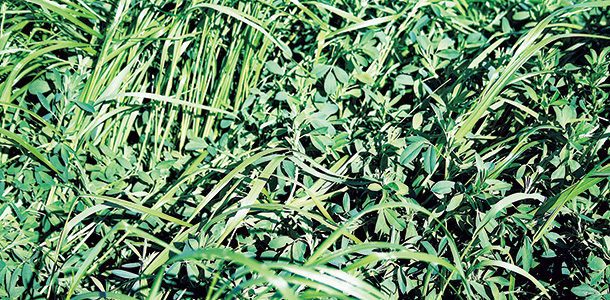Reasons to consider for growing a mixed stand can be broadly divided into agronomic reasons or animal-based reasons.
Why agronomists like grass
Yield is king; that still rings true today. High land costs and input costs make this saying more valid now than ever before.
University researchers and farmers who plant mixed stands both agree alfalfa stands (with 30 to 40 percent grass included) outyield straight stands of alfalfa in the long term.
If you see a fresh-cut alfalfa field, there is very little ground cover and quite a bit of open space between plant crowns.
This represents a missed opportunity to grow forage. Grass fills in these open spaces and gives more total plants per square foot, which can translate to more yield.
Diversification has been taught in business schools and investment seminars for many years, but how often do we think of it in our farm fields?
Grasses and alfalfas often do not suffer from the same plant pests or diseases, and we often get reports of mixed stands suffering less, from leafhoppers to winterkill.
For those in Wisconsin and Minnesota, the winter of 2012 will be one to remember. Two million acres of alfalfa fell victim to winterkill. There was damage in mixed stands too, but the severity seemed to be reduced in most cases.
The high land cost has really changed the way we think about farmland. It is too expensive to not get the most for your investment.
Soil erosion is something we don’t often think about, but it steadily removes the best topsoil, leaving your land less productive even if it isn’t noticeably washed out.
The top layer of soil contains most of the organic matter and most of the recently applied fertility. This is the first thing you lose with erosion.
If you have any question about the ability of alfalfa roots or grass roots to hold soil, conduct this experiment on your own: Find an alfalfa crown and dig it up as deep as you can with a shovel (8 to 12 inches will do).
Find a grass plant and do the same. Soak them both in a bucket of water for 30 minutes, and then remove the plants from the bucket.
What you will notice is that nearly all the waterlogged soil will slough off the alfalfa roots, while the grass roots have to be shaken vigorously to dislodge any of the soil. You can imagine the difference on a sloping field after a 6-inch rain.
Rotation comes back around
Crop rotation is a concept as old as farming. The Egyptians did it, the Romans did it, and we continue to do it today – but usually on a limited basis.
From a soil health perspective, the more crops in rotation, the better. Putting some grass on the farm is a great rotation tool, and we often see corn yields following straight grass that are as good or better than following straight alfalfa.
Recent studies conducted by the University of Wisconsin and Barenbrug USA have shown improved corn yields following a single year of Italian ryegrass compared to yields following alfalfa plowdown. The nitrogen credits are there in the alfalfa plowdown, but the grass brings something else to the table.
The immense root mass of grasses is great for soil life, conditions the soil and recycles more nutrients than alfalfa.
What’s in it for the animal?
Grass is too high in fiber to be fed to dairy cows. When dairy science was only looking at acid-detergent fiber (ADF), neutral-detergent fiber (NDF) and protein, it was thought that too much NDF would limit intake and lower the energy value for a given feed.
If we compare the NDF level of silages made from corn, alfalfa or grass, the grass had the highest NDF level and was therefore thought to be low-energy.
In response, grass was eradicated from Midwestern farms 30 to 40 years ago to make room for the higher-quality alfalfa and corn silage.
With the advances in the understanding of fiber digestibility, we now understand what the cows had been telling us all along: There was energy in grass.
The term NDFD (the percentage of the NDF that is digestible in a given timeframe) sheds some light onto the energy content of grass as a forage.
While most alfalfa samples have an NDFD around 50 percent or less, and corn silage has an NDFD of 50 to 60 percent, grasses routinely test at 60 to 70 percent NDFD.
If two-thirds of the NDF in the forage is digestible and usable as an energy source, that will likely mean less grain is needed to maintain milk production, and since grasses have almost no starch, energy increases while decreasing the starch load.
Components pay
One almost-universal response when dairies add grass to the ration is an increase in butterfat. We don’t always see a milk yield response, but energy-corrected and fat-corrected milk do go up.
Since butterfat level is largely driven by digestible fiber and the production of acetic acid in the rumen, it makes sense that adding the forage highest in digestible fiber would positively impact butterfat production.
Herd health
Speaking of butterfat, from a herd health perspective, a drop in butterfat often signals trouble with herd health.
Adding grass to the ration supplies energy without causing a drop in rumen pH, and it supplies the effective fiber ruminants need for optimal rumen health.
The most dramatic examples of improved herd health come from farms that switch from confinement to grazing, but even farms that simply add grass to the TMR on their conventional confinement farms report improved reproduction, reduced laminitis and increased cud chewing. All of these factors translate into significant economic improvement.
Why isn’t everyone doing it?
With all these positives, why isn’t the adoption of grass back onto the farm universal? Here are three reasons that slow this growing trend.
Variability can be a killer in dairy farming. “Grass” is a big term, and the variability between species and varieties creates more variation than we see in alfalfa or corn.
Nearly all of the grasses we use are cool-season grasses, meaning they don’t grow well in the hot, dry summers.
This creates a situation where spring and fall cuts of a mixed stand will have a high proportion of grass, while summer cuts will be higher in alfalfa. This variability causes some uneasiness among nutritionists.
People who tried this concept 25 years ago probably did not have access to the right grass genetics. Mixed stands are cut when the alfalfa is ready, and older grass genetics tend to be earlier maturing, meaning the grass is headed out and drying down when alfalfa comes into bloom.
This forage really would be lower-quality than a straight alfalfa stand. However, with modern grass breeding, there are varieties of fescues, orchardgrasses and other species that are just coming out of the boot stage when alfalfa starts to bloom. Mixed stands cut at this stage will have superior forage quality.
Weed and pest control options are more difficult in a mixed stand, which discourages some producers. While it is true that we see fewer weed and pest issues in mixed stands, the fact remains that it is difficult to control grassy weeds in a stand that is 30 percent grass. Be aware of your options before you plant.
Take-home lessons
Newer, improved grass varieties and higher land prices have brought new interest to mixed grass and alfalfa stands.
Issues like higher-forage diets, the need to protect against soil erosion, the need for better herd health and the need for more efficient production of milk have all combined to point to the higher yield and higher digestibility of European cool-season grasses.
As with any viable new technology, comfort levels with producing mixed hay and haylage will surely increase in popularity as the realization of the quality and yield of this crop spreads. FG
PHOTO
Grass and alfalfa mix. Photo courtesy of Chad Hale.

Chad Hale
Research and Acquisitions Manager
Byron Seeds











